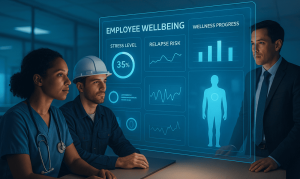In an era when employee wellbeing is more than a “nice to have”, organisations are turning to advanced tools to understand emotional patterns over weeks and months. One of the most promising developments is AI mood tracking, leveraging technology to observe emotional shifts, flag trends, and create actionable insights across time. When used thoughtfully, it moves the conversation from reactive “how are you today?” to a strategic “how have you changed over months?” and opens up new horizons in workforce wellness.
Below we’ll explore how AI mood tracking works, why it matters for business leaders, how it supports continuous employee wellbeing, and how you might embed it into your organisation’s culture.
Why tracking mood over time matters
Most wellbeing efforts still rely on annual or quarterly surveys. These snapshots capture a moment in time, but they miss the cumulative story: how an employee’s emotional state evolves, dips, recovers—or doesn’t. With longitudinal wellbeing AI, you gain visibility into trends, not just urgent alerts.
For example:
- Research shows that more than 40 % of sickness claims in some firms are due to mental or behavioural disorders.
- Organisations using advanced analytics including workplace analytics AI report reductions in absenteeism and better engagement outcomes.
By tracking mood shifts using AI over time, you can spot early warning signs of disengagement, burnout or stress—before they become full-blown issues.
How AI mood tracking works in practice
Here is a breakdown of how an organisation might put in place a long-term mood-tracking programme using AI:
- Data collection over time
- Use wearable or biometric sensors, app check-ins, self-reports and optionally digital work patterns (with consent) to gather emotional data.
- Feed the data into machine-learning models that support predictive mood monitoring. In research, such approaches have been shown capable of forecasting mental health states by analysing multiple physiological and behavioural markers.
- Use wearable or biometric sensors, app check-ins, self-reports and optionally digital work patterns (with consent) to gather emotional data.
- Emotional trend analysis
- The system plots mood or sentiment curves across time daily, weekly, monthly. This allows your HR or wellbeing teams to see whether an employee’s baseline is shifting upwards or downwards.
- Example metric: “In-month average mood score declined by 12% compared to previous quarter”.
- Also possible: segmenting by team, role, or location to identify structural issues (e.g., one team declining faster than others).
- The system plots mood or sentiment curves across time daily, weekly, monthly. This allows your HR or wellbeing teams to see whether an employee’s baseline is shifting upwards or downwards.
- Reflection and feedback loops
- Equip employees with dashboards or periodic prompts that invite reflection: “In the last six weeks your focus periods have dropped by X, your self-reported stress rose by Y”.
- Use reflection AI to generate personalised insights: e.g., prompt the employee: “You reported higher tiredness after late meetings; would you like suggestions to optimise your schedule?”
- Equip employees with dashboards or periodic prompts that invite reflection: “In the last six weeks your focus periods have dropped by X, your self-reported stress rose by Y”.
- Integration with broader wellbeing strategy
- Use the insights for individual coaching, team interventions or policy changes. For example, if a cluster of employees shows similar emotional downturns after events, consider revising scheduling or support.
- This is where you might connect mood-tracking to remote coaching AI or programmes aimed at absenteeism reduction.
- Use the insights for individual coaching, team interventions or policy changes. For example, if a cluster of employees shows similar emotional downturns after events, consider revising scheduling or support.
Key benefits for business leaders
Here’s why you, as a business leader or HR executive, should pay attention to long-term AI mood tracking:
- Better talent retention & engagement – When employees feel emotionally supported over time, engagement rises and attrition falls.
- Early intervention, not just reactive – Instead of waiting for visible crises, you catch emerging issues.
- Data-driven decision making – Rather than speculation or anecdote, you can see measurable mood trends and base interventions on them.
- Customised support & care – Using predictive mood monitoring, you can tailor support rather than one-size programmes.
- Culture shift toward continuous wellbeing – When mood tracking is ongoing, wellbeing becomes embedded, not an annual checkbox.
For instance, companies using AI-enabled wellness systems have noted up to a 21 % drop in absenteeism and a 14 % boost in productivity.
Real-world steps to implement: a roadmap
Here is a practical five-step roadmap to help you embed long-term AI mood tracking in your organisation:
Step 1: Set the baseline
Define what you want to measure: mood scores, sentiment trends, self-report check-ins, behavioural markers. Establish current state: average mood score baseline, absenteeism rates, engagement metrics.
Step 2: Choose the right architecture
Pick technologies that deliver continuous wellbeing tracking (not just one-off surveys). Ensure you have privacy, consent, and transparency built in. Use analytics that support emotional trend analysis and predictive modelling.
Step 3: Pilot with a target group
Start with a team or business unit. Run tracking for, say, six months. Review emotional trend curves, user feedback, and how interventions work.
Step 4: Integrate into work-flows
Make the insights actionable. For example, link mood-tracking alerts to your coaching or scheduling systems so if an employee’s mood baseline drops, a check-in is triggered, perhaps via a chatbot or human manager. This builds out an inclusive support system rather than stand-alone tracking. For example, if you already use AI meditation sleep programmes, you could link mood drops to recommending sleep-oriented support.
Step 5: Monitor, adjust and scale
Use data to monitor results: Has the mood baseline improved? Are absenteeism rates falling? Are feelings of wellbeing rising? Use these results to refine the system, expand rollout, and embed mood-tracking into your broader wellbeing strategy.
Pitfalls and how to avoid them
While the potential is substantial, there are important caveats:
- Privacy and consent — Employees may resist if mood tracking feels intrusive. Make participation voluntary, anonymise where possible, and be transparent. Research notes risks when AI is perceived as surveillance.
- Over-focus on metrics rather than meaning – Mood scores are data points, not human stories. Use them to prompt conversations, not replace them.
- Ignoring human context – The data may show a downward trend, but the cause might be non-work-related (family, health). Use mood tracking as a starting point for dialogue, not as definitive.
- False positives or overreach – Predictive mood monitoring is powerful but not perfect. Use human judgment alongside it.
- Lack of actionability – Tracking without follow-through will undermine trust. If employees see no change after viewing their trends, they may disengage.
Example scenarios
- A mid-sized financial services company introduced mood-tracking across its hybrid workforce. After three months, it noted that Monday morning mood scores were consistently ~8% lower in the remote team vs the in-office team. Using this insight, they introduced optional “virtual water-cooler” sessions and adjusted workload start times, resulting in a 12% improvement in mood scores in following weeks.
- A technology firm integrated mood tracking with its employee sentiment AI platform. They detected a downward trend in engineers just before major product launches. The HR team arranged short “pulse check” coaching sessions, and six months later they reported a 9% drop in unplanned absenteeism and higher job-satisfaction scores.
- A retail brand used continuous wellbeing tracking to monitor frontline staff mood throughout seasonal peaks. When the AI indicated elevated stress levels after long night shifts, management rotated schedules and introduced micro-breaks, resulting in a 16% reduction in overtime-related absenteeism.
Future trends: where mood tracking heads next
- Deeper integration with workflows: Mood signals will increasingly link to scheduling systems, task assignment and even workspace design.
- Stronger predictive capabilities: Future models won’t just track mood history—they’ll forecast likely future emotional states and suggest proactive interventions.
- More seamless user-experience: From passive sensing (wearables, voice tone, keyboard activity) to app check-ins, the friction will drop and adoption will rise.
- Ethical and human-factors design: As mood tracking becomes more widespread, organisations will need stronger governance, transparency and trust.
- Broader ecosystem connection: Mood tracking will tie into construction mindfulness, wellness programmes and broader organisational analytics to create holistic employee-centric ecosystems.
Summary and key take-aways
- Long-term AI mood tracking offers a richer view of employee wellbeing than one-off surveys.
- By applying emotional trend analysis, continuous wellbeing tracking and predictive mood monitoring, organisations gain actionable insights.
- Implementation should combine data tools, leadership intention and human support.
- Metrics matter, but human trust and ethical design matter more.
- For business leaders, mood tracking is not just about wellbeing—it’s about unlocking higher engagement, better retention and a future-ready workforce.
If you’re focused on creating an organisation where people feel supported week-in, week-out (not just at annual check-in), then embedding AI-based mood tracking is a strategic step. Pair it with smart intervention, transparent communication and action—and you’ll shift from thinking “how are we doing today?” to “how are we doing over time?”.




